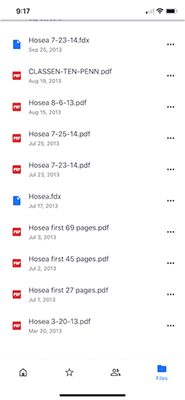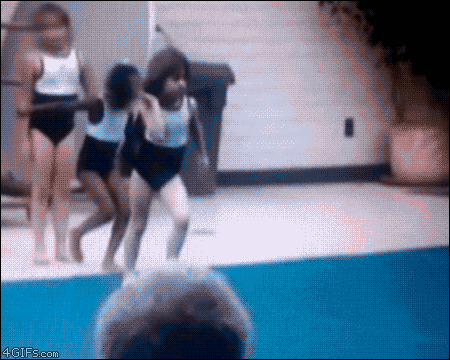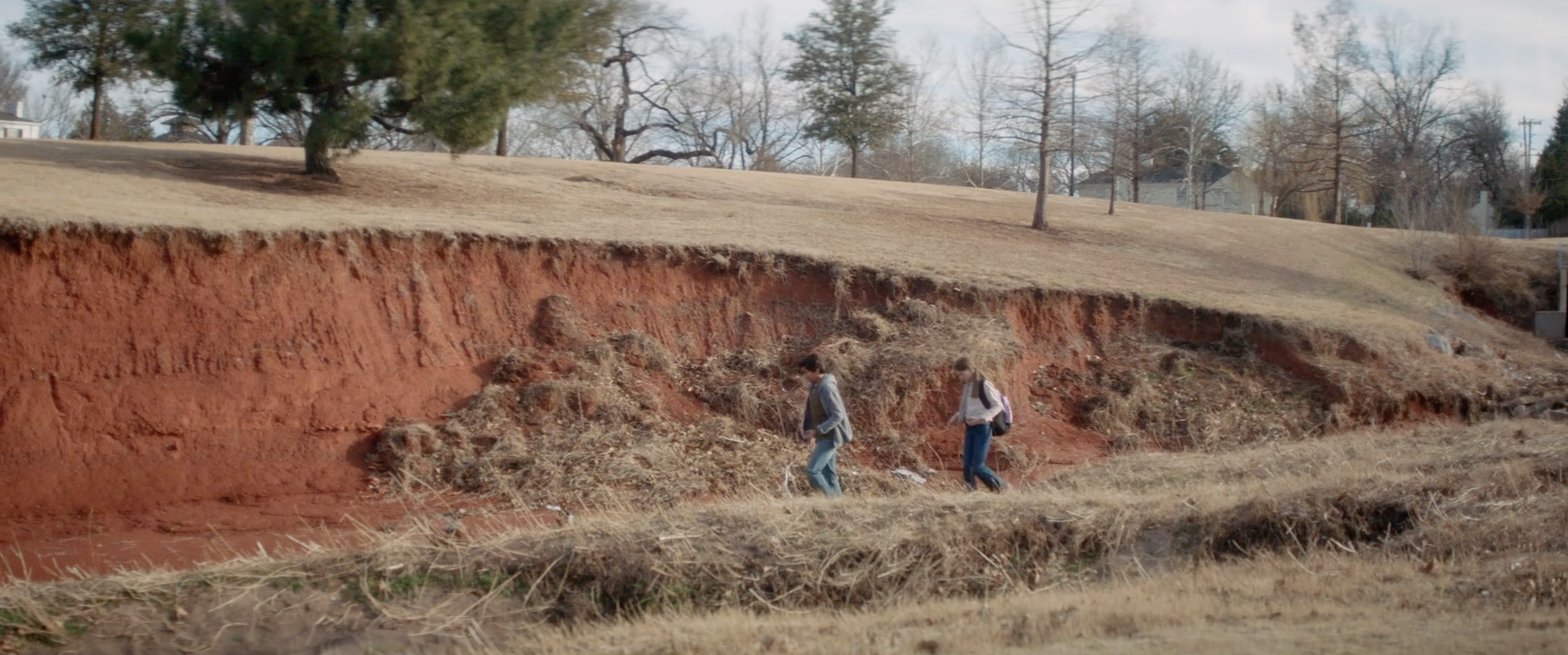Part 03: Welcome to the Weeds
At this stage in the story of making Hosea, anything I mention will represent a significant abbreviation of what actually took place. I’m skipping over huge swaths of time. We raised money, and that’s not easy. We partnered with many people, some of whom didn’t work out. And we re-wrote the script about a billion times. Seriously.
If you don’t believe me when I say a billion drafts, take a look at this screen recording I took of the Google Drive folder where I backed up every draft of the script. This is just a sampling of how many drafts we have saved!
To sum it up: for a long time we prodded and pleaded and prayed our film would make it and along the way we learned important lessons, some of which I’m going to share with you now.
• • •
Lesson #1: Table reads are exercises in humility.
A table read is when you take a script that you, the writer, have mistakenly decided is definitely ready to see the light of day. You have honed the story, refined the witty dialogue, and now feel prepared to throw back the curtains on the genius of your creation. So, you go beg some actors to sacrifice their time for you and do a seated performance of your script—literally, actors taking on roles and reading their lines aloud while sitting down around a table with you—all for the sake of “hearing the words out loud” to ascertain the quality of the story.
In my experience, table reads are akin to feeling like you’re ready for a gymnastics competition, and then… well, words don’t suffice, so here’s a GIF that describes how it feels:
Maybe some writers exist out there who have incredible table reads that leave everyone charmed and secretly stunned by the sheer brilliance of the text. I’m sure that’s how it goes for Aaron Sorkin. However, in my experience, table reads often feel like I’m being asked to publicly expose the inadequacies of my creation—and that can be a very tough exercise. However, it’s a necessary exercise, regardless, because the story you’re telling always benefits from being read aloud. I know that’s true because I know that the work of the generous and gifted actors who took part in our table read made Hosea better.
• • •
Lesson #2: Some of your (best?) work will die in silence.
Our primary shooting location (and production office) was in an old, vacant Catholic school called Villa Teresa. In one of the top floor rooms, where the nuns lived, we found windows lined with these tissue paper designs. Who knows how many years they had been clinging to these windows, their craftsmanship going completely unappreciated, their delicacy recognized by no one but the rays of sunlight that shone through the glass?
I would imagine that writers of all stripes, from journalists to authors to filmmakers like me, often put inordinate amounts of time into an idea that never sees the light of day. As I wrote Hosea, I would often come up with some thought or concept that fascinated me, and I would end up fixating on it for days or even weeks. I would carefully weave this idea into the story, deeply embedding it in the action and dialogue—only to later have it completely stripped out because it was either a) impossible, b) too expensive, c) too cheesy, d) too clunky, e) simply not helpful to the story, or f) all of the above.
For instance, in Hosea, we jump over a large gap of time early on, when the film transitions from young Cate and Henry to the adult versions of those characters. We know little about what occurred over these missing years, except for a passing reference to letters that Cate and Henry used to send one another after Henry moved away.
However, in earlier versions of the script, those letters played a more prominent role. For a good portion of the script’s history, I envisioned the letters being read as voiceovers, layered under beautiful B-roll of that gorgeous big sky Oklahoma always has. I had the “brilliant” idea (or so I thought!) to base the text of these letters on the actual poetry within the biblical book of Hosea, which meant I spent way too much time sitting in coffee shops, filling the pages of my journal with love poems loosely based on Bible verses that I then wove into the script.
Later on—much later on—I had to come to terms with the fact that even though I had poured so much time into crafting each and every line, these poems presented a big problem for a low budget movie were every page counts: they didn’t move the story along in a meaningful way. So I cut them. But in the spirit of table reads, I thought it’d be fun to show you some of these poems:
Lesson #3: The difference between a good movie and a great movie is not you.
Indie filmmaking often requires always requires people to extend themselves a bit beyond the typical requirements of their given job. A producer has to be willing to suddenly step in and run craft services. Avi, the actor who played Henry, jumped in to help Cameron in the props department light candles. This is the way of scrappy art.
However, the downside of this model is that it’s easy to take on jobs at which you are not particularly good. I'm speaking from personal experience here: when needs arose on set, my kneejerk reaction was to try to fill that need myself (don't you realize this stuff has to get done???). A major problem with my approach, though, is that I’m not that good at most jobs. Fortunately, this predicament has the easiest of solutions: find people who are better than me at these jobs (there's plenty of them out there!), and let them work their magic. Trust me, the people working on your team will always elevate your film when you just let them do their thing.
On the road to Hosea, we met Avril Z. Speaks, a Los Angeles-based film producer. Suzanne and I had been looking for another partner, another voice on the film. We wanted someone who knew a bit more about indie filmmaking and also understood the kind of story Hosea was. Avril had just finished producing an award-winning movie called Jinn. Like Hosea, Jinn had a female lead and contained a religious component. This made her a perfect match for us, and she brought a tool bag full of expertise and thoughtfulness to our team.
When people like Avril joined Hosea, when they added their color to our painting—that's what took the film from good to great.
• • •
Lesson #4: Investors are silent heroes.
All art needs the support of patrons, and filmmaking is no exception. Making a movie is an incredibly costly endeavor—even for scrappy teams like ours who know how to squeeze the value out of every dollar. There’s two types of patrons, I think, and both are equally important.
The first type is the early supporters, the people who help get the art started. Making a film basically means starting a small business, literally: you form an LLC, you hire employees, you purchase insurance, you get an office, and so on. None of that can happen, though, without the support of people who believe in your movie. Those people are the first type of patron.
That makes you—yes, you, the person reading this—the second kind of patron. Movies, as a form of art, need to be purchased. It’s just like your local coffee shop: if you don’t buy their lattes, the shop will go out of business. It really is that simple. You rented or bought our movie, and that means you’ve done your part. Your support makes it easier for other thoughtful movies like ours to get made in the future. Thank you. You’re a patron.










